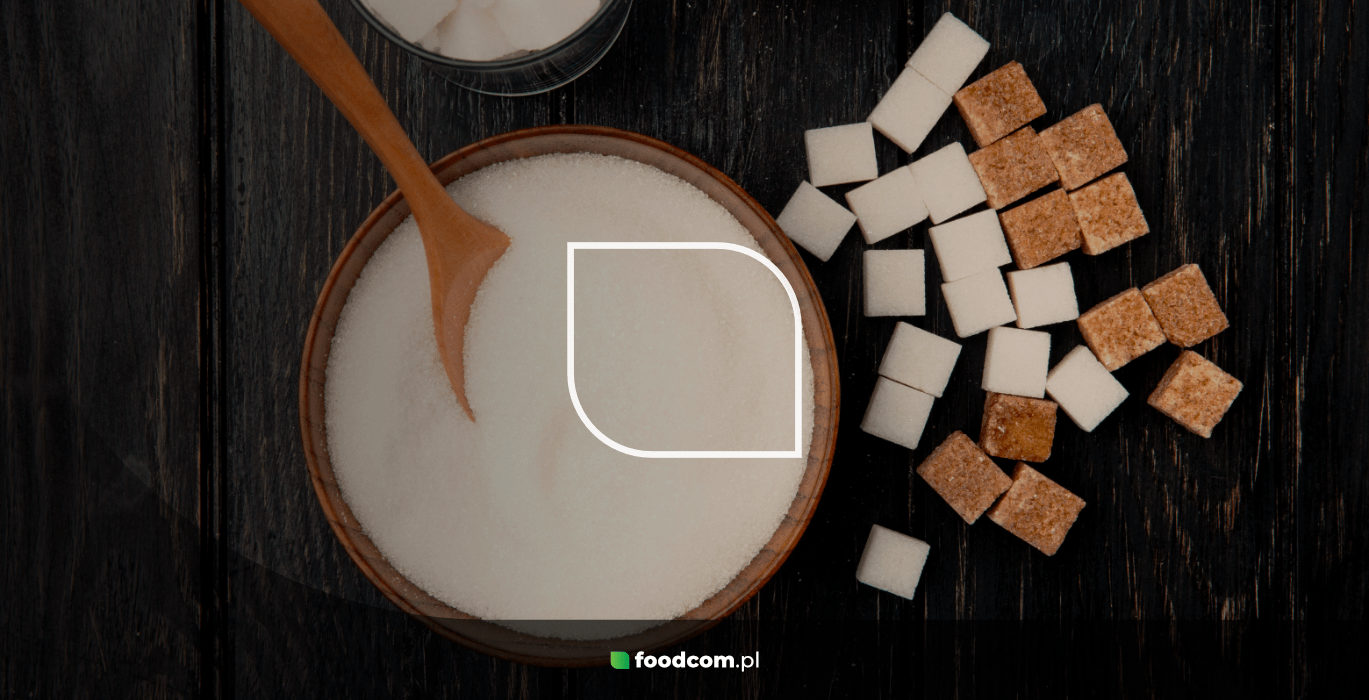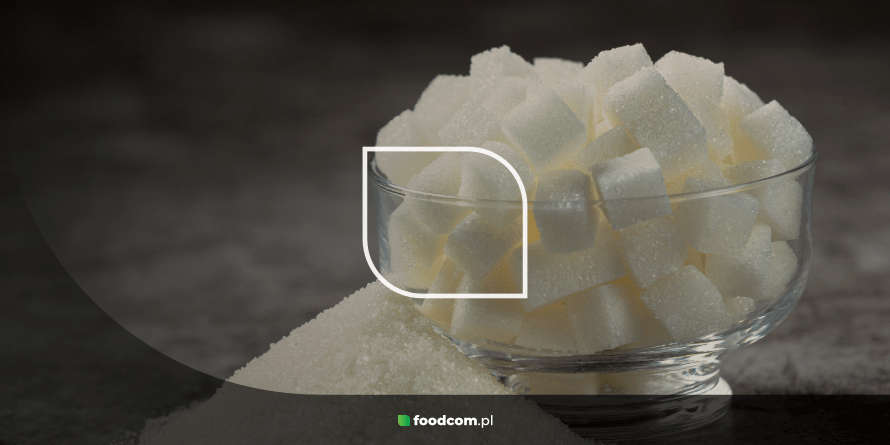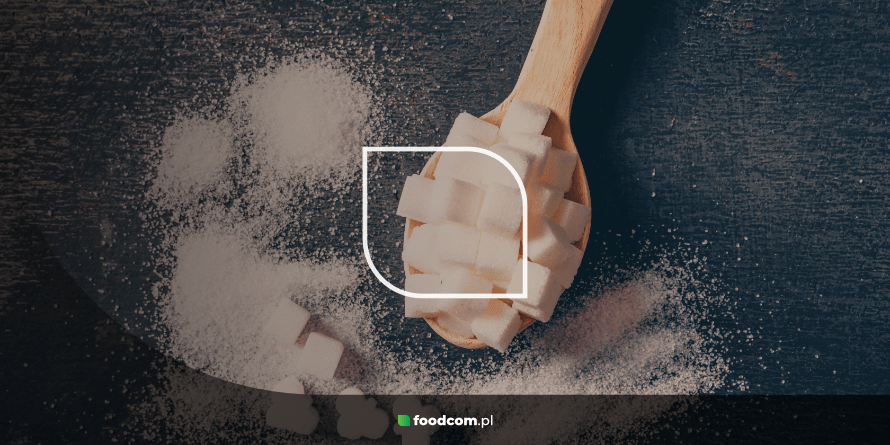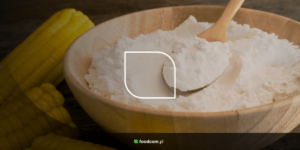- Sugars are a diverse group of substances – the term refers to classic white sugar, natural sugar alcohols, and synthetic sweeteners.
- Different types of sugars have different technological properties and applications in the food, pharmaceutical, and cosmetic industries.
- Foodcom S.A. offers both classic sugars and modern substitutes with reduced calorie content or a low glycemic index.
Sugars – although often associated mainly with white table sugar – are a broad group of carbohydrate compounds with different physicochemical, taste and technological properties. Understanding these differences is crucial when designing formulations for food products, beverages, dietary supplements or pharmaceutical preparations.
What are sugars? Basic division and role
Sugars are organic chemical compounds that have a key energy and structural function in living organisms. They are an essential source of energy, especially for the brain and muscles, and are part of numerous metabolic processes.
Basic division of sugars
Sugars can be divided into several categories:
- monosaccharides – simple sugars consisting of a single molecule (monomer) that the body can use as a source of energy immediately after ingestion, e.g. glucose, fructose, galactose;
- disaccharides – made up of two molecules of simple sugars, e.g. sucrose, lactose, maltose;
- oligosaccharides – short carbohydrate chains that contain 2-10 monomers linked through an O-glycosidic bond; play an important role in the intestines, among other things;
- polysaccharides – complex sugars; multi-molecular compounds consisting ofmonosaccharides linked together in chains, broken down during digestion into smaller molecules are released into the blood, e.g. starch, maltodextrin, glycogen, cellulose;
- sugar alcohols – sugar derivatives, e.g. sorbitol, xylitol, erythritol;
- sweeteners – synthetic or natural substances with very high sweetness, e.g. aspartame, sucralose.
Each of these types of sugars exhibits different physico-chemical and metabolic properties, which translates into their specific use in industry.
Functions of sugars in the body
Sugars do not just serve as a carrier of taste – they have many important biological roles:
- energy source – glucose is a fuel for cells and the primary substrate in the Krebs cycle, which is particularly important for brain and muscle function and building up energy reserves (in the form of glycogen);
- regulation of metabolism – sugars are involved in insulin management and glycaemic balance;
- osmotic role – they support the maintenance of osmotic pressure in body fluids.
- construction of biological structures – sugars are incorporated into DNA, RNA, glycoproteins or cell membranes.
Industrial uses of sugars
Sugars and their derivatives are extremely valuable technologically – depending on the type, they can play roles:
- sweetening – they improve the taste and attractiveness of products;
- preservatives – they limit the growth of microorganisms;
- texturising – they affect the texture;
- moisture stabilisers – help keep products fresh;
- functional – as prebiotics, ingredients in specialised diets or nutraceuticals.
They are widely used in a variety of industries:
- food – confectionery, beverages, bakery, dairy, functional products;
- pharmaceutical – syrups, tablets, dietary supplements;
- cosmetics – creams, pastes, lotions (due to their water binding and stabilising properties);
- chemical and animal feed – e.g. as carriers of active substances.
The most important sugars – an overview
Below is an overview of the most important sugars used in industry and their applications.
White sugar
White sugar is the classic form of table sugar – purified sucrose, a disaccharide made up of glucose and fructose. It is extracted from sugar beet or sugar cane and then refined and crystallised. It is characterised by its versatility, high sweetness and easy availability, while its disadvantage is its high glycaemic index. It is used in the food industry, in the production of preserves and beverages, as well as alcohol.
Glucose (grape sugar)
Glucose is a monosaccharide with rapid metabolism and high energy content – it is very high in calories. It is in this form that sugar is found in our blood. Glucose is well soluble, lowers the freezing point of products and their viscosity and stabilises their texture. It is also used as a preservative for jarred and canned foods. It is most commonly found in liquid form as an ingredient in isotonic drinks, sports formulations and in the pharmaceutical industry (e.g. as an ingredient in infusion and electrolyte fluids).
Dextrose (D-glucose)
Dextrose or dextrose monohydrate is a pure, crystalline form of glucose usually obtained from maize. It activates yeast, improves viscosity and stabilises the colour and flavour of products, so it is mainly used in bakery, meat processing, dairy and feed industries. Dextrose is less sweet but more soluble in water than sucrose. It is also sometimes used in medicines, especially intravenous solutions.
Fructose
Fructose is a sugar naturally found in fruit. It is sweeter than sucrose, allowing higher sweetness with less sugar. The metabolism of fructose occurs without insulin, so it is often used in energy bars, diet products and jams as a sweetener and preservative. Thanks to its ability to retain water, in baked goods it helps to prolong shelf life, and it also gives a smooth texture to ice cream.
Maltodextrin
Maltodextrin is a polysaccharide with a neutral taste, low sweetness and high solubility index. It is produced by enzymatic hydrolysis of starch from plants, most commonly from maize, but also from rice and wheat. It is used as a filler in powders, flavour carrier and fat substitute. It is characterised by its high stability, thus extending the shelf life of products. In addition, it improves the texture and flavour of products – it is used in canned foods, meat, baked goods and confectionery, and as a feed ingredient.
Xylitol
Xylitol is a natural sugar alcohol with a low glycaemic index. Formerly extracted from birch trees (hence its other name – birch sugar), it is now obtained by reducing xylose or with yeast. It does not cause tooth decay and has fewer calories than sucrose, but in excess can have a laxative effect. It is mainly used in dietetic and sugar-free products, in products for diabetics and in the manufacture of toothpaste.
Erythritol
Erythritol is a zero-calorie alcoholic sugar with no glycaemic effect. It is well tolerated and does not ferment in the intestines. It is obtained by the fermentation of glucose and occurs naturally in fruit, fermented foods or red wine. In industry, it is found in diet products, beverages or sugar-free baked goods (it is heat stable). It is also used as an additive in medicines.
Sorbitol
Sorbitol is a sugar alcohol with less sweetness than sucrose, naturally occurring in dried fruit and obtained by reducing glucose from potato starch. Due to its hygroscopic nature, it improves the moisture content of the final product. It is used in chewing gum, diabetic products, medicines and cosmetics.
Glucose-fructose syrup (HFCS)
Glucose-fructose syrup is a liquid sweetener with a varying ratio of glucose to fructose and often contains other sugars. It is most commonly derived from corn. It is added to a variety of processed products such as baked goods, fizzy drinks, sauces or ice cream, where it prevents crystallisation. It is characterised by its easy processing, as well as its longer shelf life and lower cost compared to sucrose.
Sugar substitutes (intense sweeteners)
In addition to classic sugars, many companies, including Foodcom, also offer intense sweeteners as a substitute. These can be, for example:
- aspartame – a peptide ester up to 200 times sweeter than sucrose, low in calories; it is used in light drinks, sugar-free products and dietary supplements;
- sucralose – approximately 600 times sweeter than sucrose, is produced by chlorination, has a neutral taste and no calories; is heat stable and easily soluble, so is used in baked goods, as well as beverages, dairy products and supplements;
- acesulfame K – heat stable, no calories, often used in mixtures with sweeteners (e.g. aspartame) in chewing gum, beverages;
- stevia (steviol glycosides) – a natural sweetener from the leaves of the Stevia rebaudiana plant, is characterised by its lack of calories and low glycaemic index, and is used in dietary and functional products, supplements and children’s products.
The type of sugar chosen for a specific product is not just a question of sweetness – it is an important technological and marketing decision. By offering a wide range of sugars and sweeteners, Foodcom S.A. responds to the diverse needs of the market – from classic solutions to modern, low-calorie sugar substitutes.










